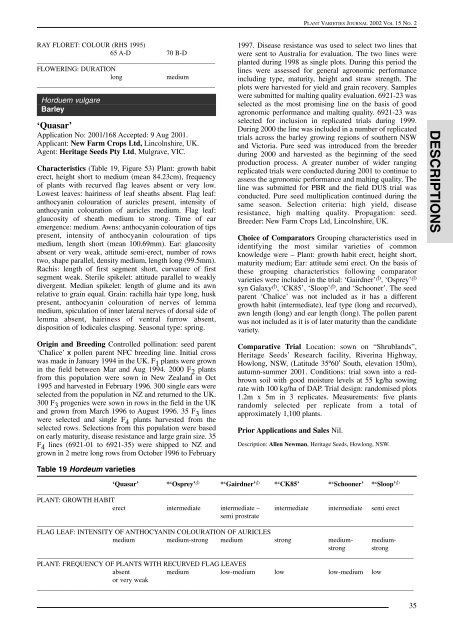44. Volume 15- Number 2 - IP Australia
44. Volume 15- Number 2 - IP Australia
44. Volume 15- Number 2 - IP Australia
You also want an ePaper? Increase the reach of your titles
YUMPU automatically turns print PDFs into web optimized ePapers that Google loves.
DESCR<strong>IP</strong>TIONS<br />
PLANT VARIETIES JOURNAL 2002 VOL <strong>15</strong> NO. 2<br />
RAY FLORET: COLOUR (RHS 1995)<br />
65 A-D 70 B-D<br />
____________________________________________________<br />
FLOWERING: DURATION<br />
long<br />
medium<br />
____________________________________________________<br />
Horduem vulgare<br />
Barley<br />
‘Quasar’<br />
Application No: 2001/168 Accepted: 9 Aug 2001.<br />
Applicant: New Farm Crops Ltd, Lincolnshire, UK.<br />
Agent: Heritage Seeds Pty Ltd, Mulgrave, VIC.<br />
Characteristics (Table 19, Figure 53) Plant: growth habit<br />
erect, height short to medium (mean 84.23cm), frequency<br />
of plants with recurved flag leaves absent or very low.<br />
Lowest leaves: hairiness of leaf sheaths absent. Flag leaf:<br />
anthocyanin colouration of auricles present, intensity of<br />
anthocyanin colouration of auricles medium. Flag leaf:<br />
glaucosity of sheath medium to strong. Time of ear<br />
emergence: medium. Awns: anthocyanin colouration of tips<br />
present, intensity of anthocyanin colouration of tips<br />
medium, length short (mean 100.69mm). Ear: glaucosity<br />
absent or very weak, attitude semi-erect, number of rows<br />
two, shape parallel, density medium, length long (99.5mm).<br />
Rachis: length of first segment short, curvature of first<br />
segment weak. Sterile spikelet: attitude parallel to weakly<br />
divergent. Median spikelet: length of glume and its awn<br />
relative to grain equal. Grain: rachilla hair type long, husk<br />
present, anthocyanin colouration of nerves of lemma<br />
medium, spiculation of inner lateral nerves of dorsal side of<br />
lemma absent, hairiness of ventral furrow absent,<br />
disposition of lodicules clasping. Seasonal type: spring.<br />
Origin and Breeding Controlled pollination: seed parent<br />
‘Chalice’ x pollen parent NFC breeding line. Initial cross<br />
was made in January 1994 in the UK. F 1 plants were grown<br />
in the field between Mar and Aug 1994. 2000 F 2 plants<br />
from this population were sown in New Zealand in Oct<br />
1995 and harvested in February 1996. 300 single ears were<br />
selected from the population in NZ and returned to the UK.<br />
300 F 3 progenies were sown in rows in the field in the UK<br />
and grown from March 1996 to August 1996. 35 F 3 lines<br />
were selected and single F 4 plants harvested from the<br />
selected rows. Selections from this population were based<br />
on early maturity, disease resistance and large grain size. 35<br />
F 4 lines (6921-01 to 6921-35) were shipped to NZ and<br />
grown in 2 metre long rows from October 1996 to February<br />
Table 19 Hordeum varieties<br />
1997. Disease resistance was used to select two lines that<br />
were sent to <strong>Australia</strong> for evaluation. The two lines were<br />
planted during 1998 as single plots. During this period the<br />
lines were assessed for general agronomic performance<br />
including type, maturity, height and straw strength. The<br />
plots were harvested for yield and grain recovery. Samples<br />
were submitted for malting quality evaluation. 6921-23 was<br />
selected as the most promising line on the basis of good<br />
agronomic performance and malting quality. 6921-23 was<br />
selected for inclusion in replicated trials during 1999.<br />
During 2000 the line was included in a number of replicated<br />
trials across the barley growing regions of southern NSW<br />
and Victoria. Pure seed was introduced from the breeder<br />
during 2000 and harvested as the beginning of the seed<br />
production process. A greater number of wider ranging<br />
replicated trials were conducted during 2001 to continue to<br />
assess the agronomic performance and malting quality. The<br />
line was submitted for PBR and the field DUS trial was<br />
conducted. Pure seed multiplication continued during the<br />
same season. Selection criteria: high yield, disease<br />
resistance, high malting quality. Propagation: seed.<br />
Breeder: New Farm Crops Ltd, Lincolnshire, UK.<br />
Choice of Comparators Grouping characteristics used in<br />
identifying the most similar varieties of common<br />
knowledge were – Plant: growth habit erect, height short,<br />
maturity medium; Ear: attitude semi erect. On the basis of<br />
these grouping characteristics following comparator<br />
varieties were included in the trial: ‘Gairdner’ A , ‘Osprey’ A<br />
syn Galaxy A , ‘CK85’, ‘Sloop’ A , and ‘Schooner’. The seed<br />
parent ‘Chalice’ was not included as it has a different<br />
growth habit (intermediate), leaf type (long and recurved),<br />
awn length (long) and ear length (long). The pollen parent<br />
was not included as it is of later maturity than the candidate<br />
variety.<br />
Comparative Trial Location: sown on “Shrublands”,<br />
Heritage Seeds’ Research facility, Riverina Highway,<br />
Howlong, NSW, (Latitude 35º60′ South, elevation <strong>15</strong>0m),<br />
autumn-summer 2001. Conditions: trial sown into a redbrown<br />
soil with good moisture levels at 55 kg/ha sowing<br />
rate with 100 kg/ha of DAP. Trial design: randomised plots<br />
1.2m x 5m in 3 replicates. Measurements: five plants<br />
randomly selected per replicate from a total of<br />
approximately 1,100 plants.<br />
Prior Applications and Sales Nil.<br />
Description: Allen Newman, Heritage Seeds, Howlong, NSW.<br />
‘Quasar’ *‘Osprey’ A *‘Gairdner’ A *‘CK85’ *‘Schooner’ *‘Sloop’ A<br />
______________________________________________________________________________________________________________<br />
PLANT: GROWTH HABIT<br />
erect intermediate intermediate – intermediate intermediate semi erect<br />
semi prostrate<br />
______________________________________________________________________________________________________________<br />
FLAG LEAF: INTENSITY OF ANTHOCYANIN COLOURATION OF AURICLES<br />
medium medium-strong medium strong medium- mediumstrong<br />
strong<br />
______________________________________________________________________________________________________________<br />
PLANT: FREQUENCY OF PLANTS WITH RECURVED FLAG LEAVES<br />
absent medium low-medium low low-medium low<br />
or very weak<br />
______________________________________________________________________________________________________________<br />
35

















